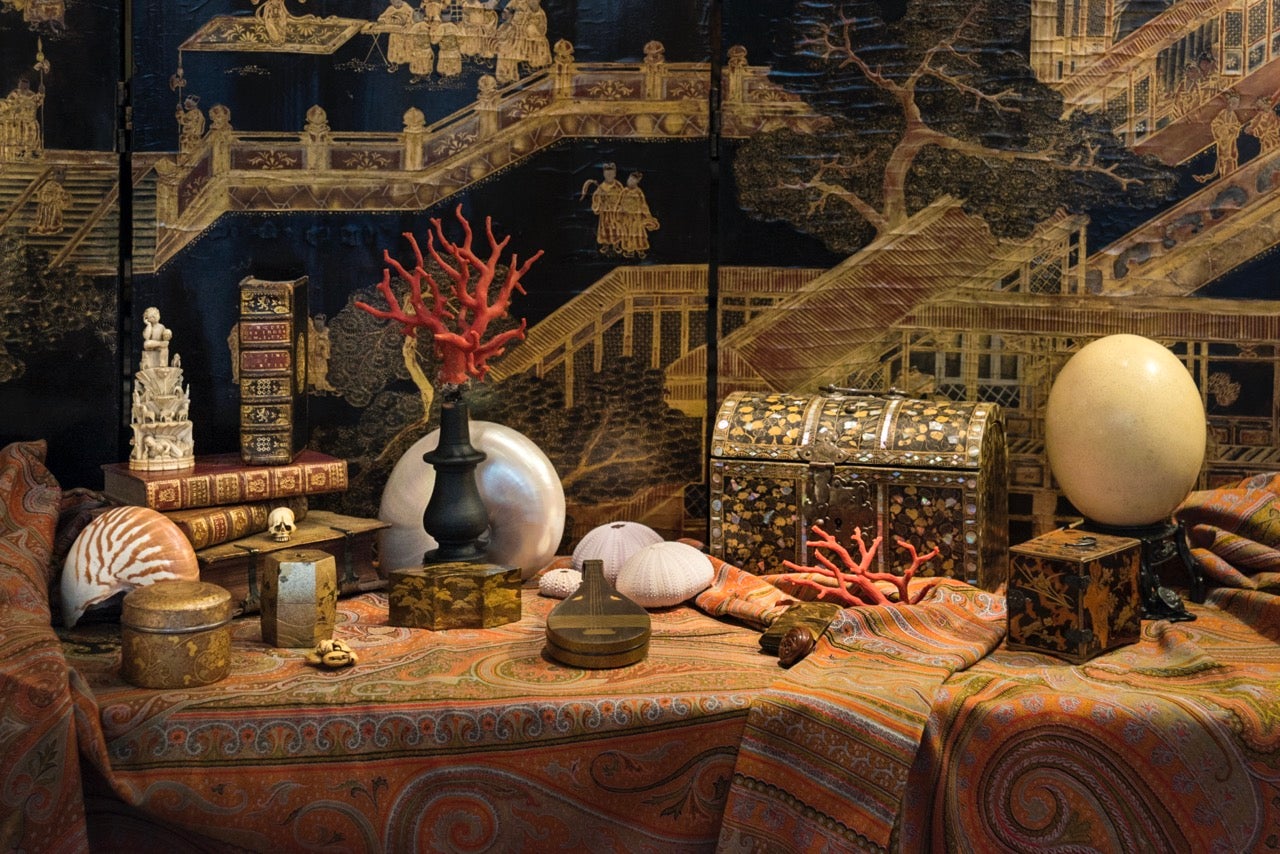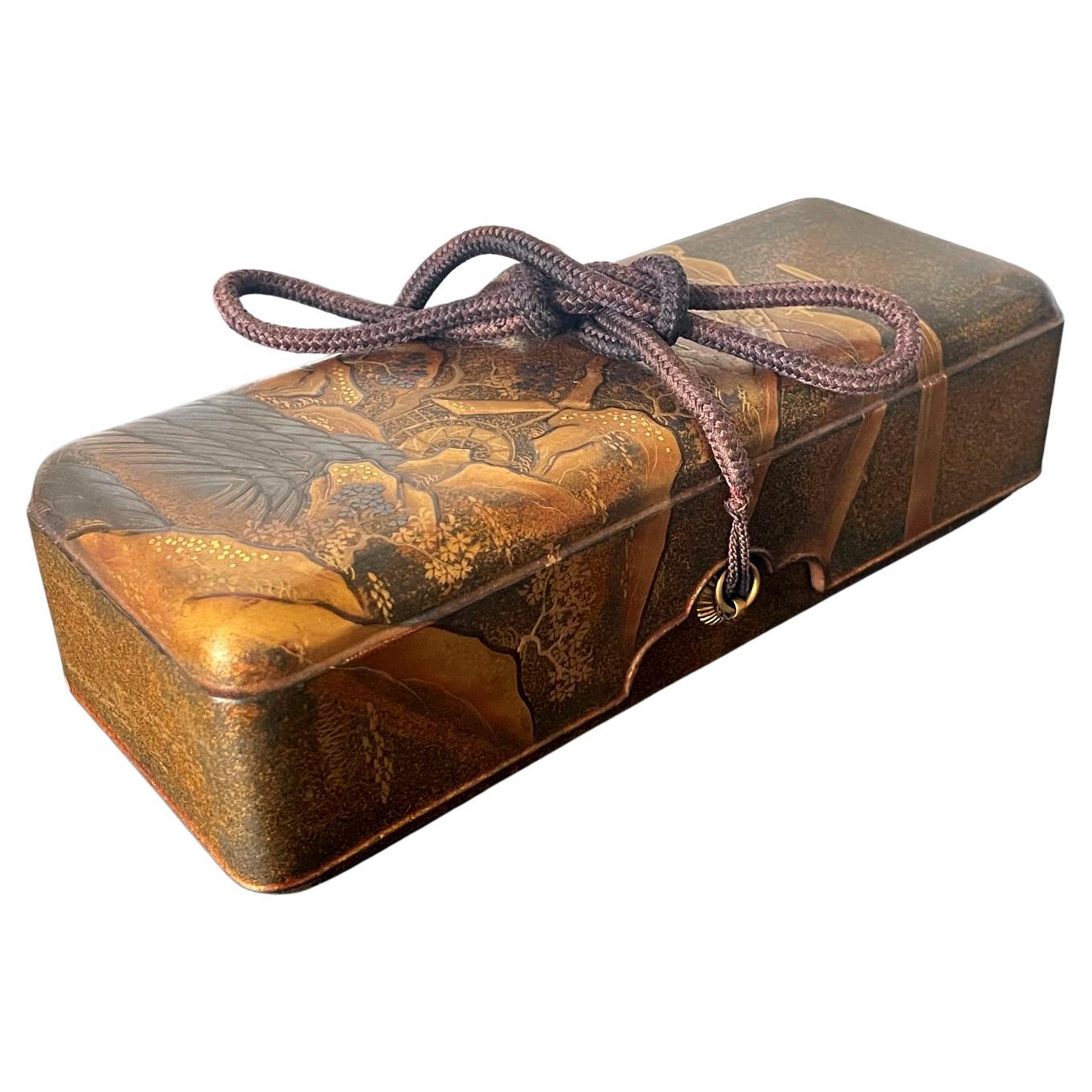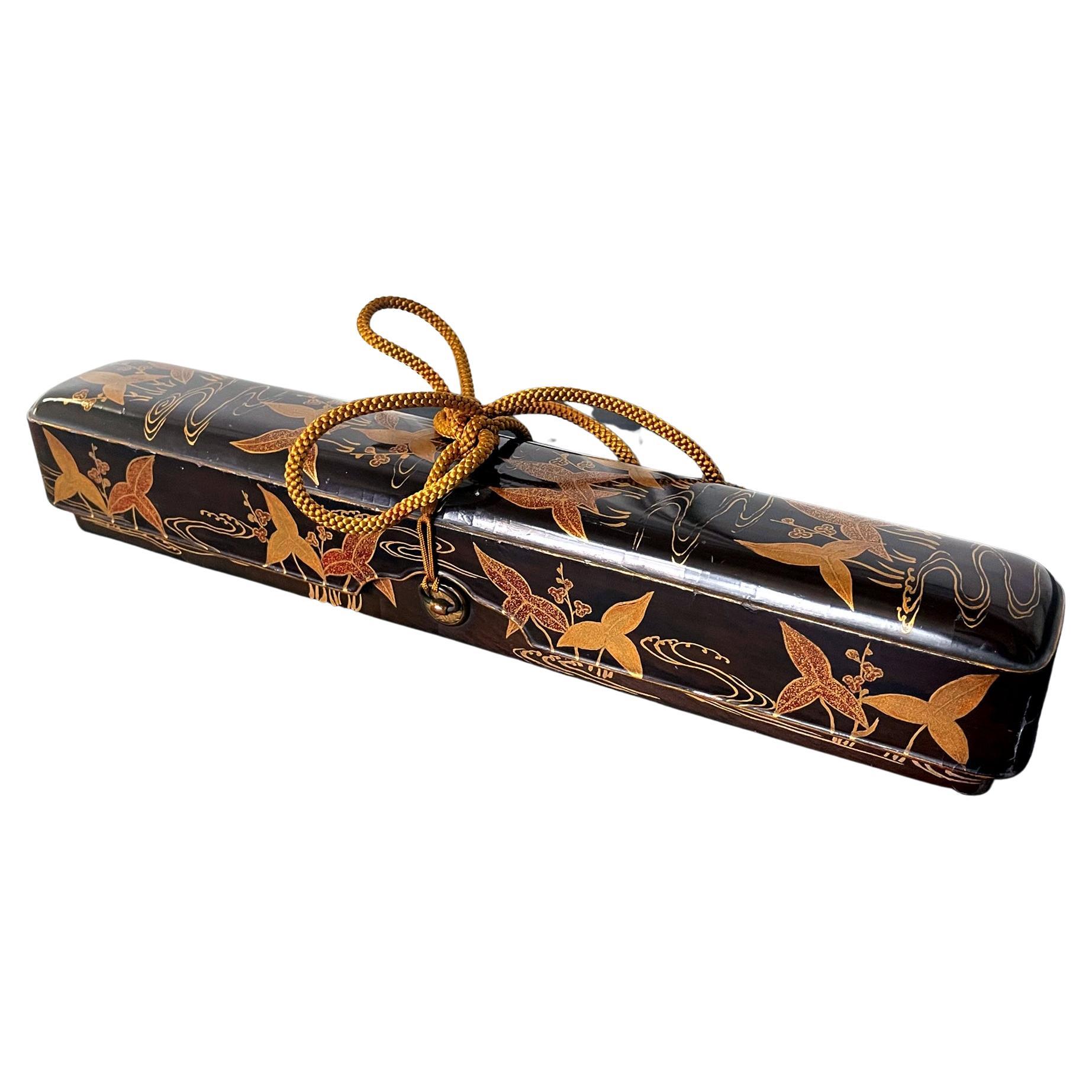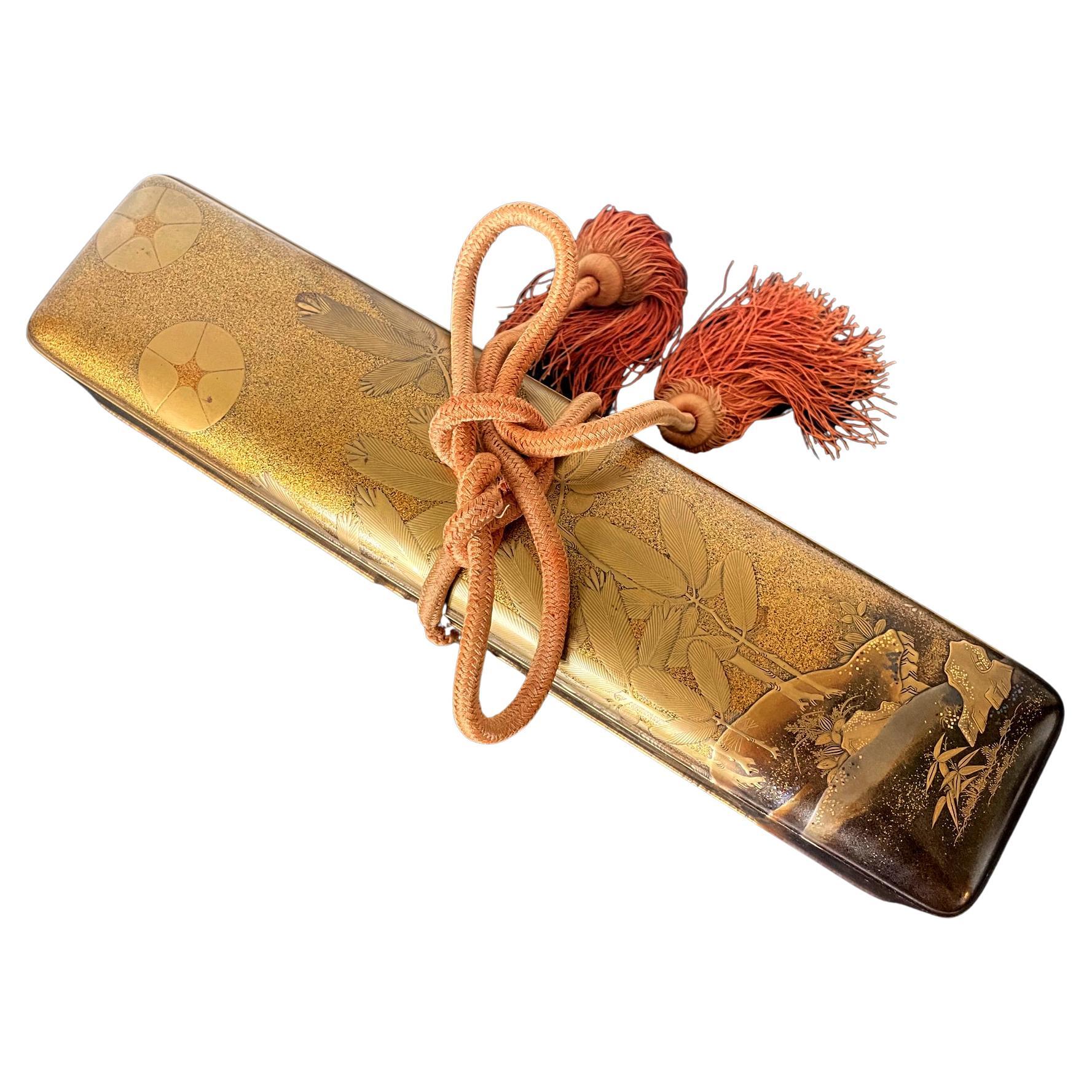Items Similar to Wakasa-Nuri Lacquer Bundai, Ryoshobako, Fubako Set
Want more images or videos?
Request additional images or videos from the seller
1 of 10
Wakasa-Nuri Lacquer Bundai, Ryoshobako, Fubako Set
About the Item
Set of bundai, ryoshibako and fudebako in wakasa lacquer with an old rose background and black traditional Japanese patterns.
The saya pattern (or sayagata) is composed by Chinese svastikas. This symbol linked to Buddhism, mean intelligence, power and peace. It is a good omen sign.
The kanoko pattern reminds stains on fawn back.
The sakura (cherry blossom) pattern is emblematic of Japan. The blossoming in a short time marks spring beginning and is a symbol of renewal and ephemeral beauty.
There are also traces of calligraphy brush, in reference to the function of the objects.
Bundai is a low table used to put books or scrolls and, later, to write.
Rectangular ryoshibako (letter and document box) with a slightly domed
Fudebako (pencil case) of rectangular format very narrow in its length with two rounded corners, flat cover.
Wakasa lacquerware (wakasa-nuri in Japanese) is a specialty of the Wakasa region in Fukui Prefecture, west of Lake Biwa on the Sea of Japan, produced from the early Edo period (1603-1868). This technique derives from togidashi maki-e and is characterized by the creation of patterns in eggshells, seashells or pine needles.
More specifically, the decoration is obtained by rubbing on superimposed layers of lacquer of different colors. This technique was not known in the West before Japan opened up to international trade*.
Japan, Taisho era (1912-1926)
Dimensions :
Bundai : Height 12.4 cm (4.88 inch) - Length 58.2 (22.91 inch) – Width 34.5 cm (13.58 inch)
Ryoshibako : Height 4.6 cm (1.8 cm) - Length 24 cm (9,45 inch) – Width 18.6 cm (7.32 inch)
Fudebako : Height 2.7 cm (1.06 inch) - Length 22.2 cm (8.74) – Width 8.2 cm (3.22 inch)
* cf Geneviève Lacombe (dir.) L’or du Japon – Laques anciens des collections publiques françaises, p. 187.
- Dimensions:Height: 4.93 in (12.5 cm)Width: 13.59 in (34.5 cm)Depth: 22.84 in (58 cm)
- Materials and Techniques:Lacquer,Lacquered
- Place of Origin:
- Period:
- Date of Manufacture:1912-1926
- Condition:Wear consistent with age and use.
- Seller Location:PARIS, FR
- Reference Number:

About the Seller
No Reviews Yet
Vetted Seller
These experienced sellers undergo a comprehensive evaluation by our team of in-house experts.
Established in 2013
1stDibs seller since 2023
- ShippingRetrieving quote...Ships From: PARIS, France
- Return PolicyA return for this item may be initiated within 7 days of delivery.
More From This SellerView All
- Black and Gold Lacquer Suzuribako 'Writing Set'Located in PARIS, FRBlack and gold lacquer suzuribako (writing set) in takamaki-e on a nashi-ji background representing two tigers near rocks, bamboos and plum blossoms in a night landscape. Inside of the lid with a lake landscape. The interior of the suzuribako is composed with an inkstone, topped by a copper water bucket in the shape of a chrysanthemum on the left side, with a brush and a small knife. It includes in the right part a storage compartment. Inscription under the inkstone "Inkstone made by Nakamura Chobe". Although the tiger is not native to Japan, it has a high symbolic. The figure of courage was introduced by Buddhism from China. According to the Chinese tradition, the tiger is from one of the stars of the Great...Category
Antique Late 18th Century Japanese Lacquer
MaterialsLacquer
- Japanese Lacquered Tebako 'Box'Located in PARIS, FRTebako box with three compartments in golden and nashi-ji lacquer, decorated with golden, red, and kirigane lacquer, golden persimmon tree leaves, among rocks. The compartments are of increasing size from the top. The decoration is in continuity. Persimmon has been cultivated in southern China for more than 2500 years and is believed to have been introduced to Japan in the 8th century. The veneer is a tree with very hard wood, similar to ebony. According to a legend, one specimen survived the atomic bombing of Nagasaki on August 9, 1945, close to the epicenter. It is therefore in Japan a symbol of strength and longevity. It is also the national fruit of the country. It is eaten as a traditional dish during New Year's Day celebrations. Tebako literally means "portable box...Category
Antique 1860s Japanese Lacquer
MaterialsLacquer
- Japanese Lacquered Natsume 'Tea Box'Located in PARIS, FRNatsume in dark red lacquer, decorated with autumn leaves and cherry blossoms in hiramaki-e and nashiji. Interior in black lacquer. Maple leaves (Momiji) are celebrated in literatur...Category
Mid-20th Century Japanese Lacquer
MaterialsLacquer
- Japanese Lacquered Furoshiki Kobako 'Box'Located in PARIS, FRRectangular and flat lacquer Kobako (small box) representing a furoshiki knot seen from above. Fundame background, furoshiki in takamaki-e with floral pattern, inside the folds of the fabric with black and gold sayagata pattern with togidashi maki-e technique. The saya (or sayagata) pattern is composed of Chinese swastikas...Category
Antique Late 19th Century Japanese Lacquer
MaterialsLacquer
- Japanese peony basket lacquered box EdoLocated in PARIS, FREight-sided, flared shaped lacquer kobako box, following the decoration on the lid depicting a basket of flowers, composed of peonies and chrysanthemums in gold takamaki-e and hirama...Category
Antique 18th Century Japanese Edo Lacquer
MaterialsGold
- Japanese Black and Gold Lacquer KushibakoLocated in PARIS, FRKushibako (comb box) in black lacquer with gold lacquer decoration of arrows and my in the shape of three assembled commas " mitsudomoe " (Okabe; Itakura; Kuki; Hijikata; Arima famil...Category
Antique Late 19th Century Japanese Lacquer
MaterialsLacquer
You May Also Like
- Japanese Lacquered Maki-e Fubako Edo PeriodLocated in Atlanta, GAA Japanese lacquered wood fubako (a box used to store document or small scroll painting), circa second half of 19th century late Edo period. The rectangular box features an unusually deep lipped lid with slightly rounded corners, a conforming lower box that is almost entirely covered by the lid which has two bronze medallion rings with tasseled...Category
Antique 19th Century Japanese Edo Lacquer
MaterialsWood, Lacquer
- Japanese Lacquered Maki-E Fubako in Kodaiji StyleLocated in Atlanta, GAA rare Japanese lacquered wood fubako decorated in Kodaiji maki-e style circa early 17th century the beginning of the Edo period, possibly early toward the end of the Azuchi-Momoyama period. The rectangular, long and slim box features a deep lipped lid with slightly rounded corners, a conforming lower box with two bronze medallion rings with tasseled...Category
Antique Early 17th Century Japanese Edo Lacquer
MaterialsWood, Lacquer
- Japanese Lacquered Gold Maki-E Naga Fubako Meiji PeriodLocated in Atlanta, GAA Japanese lacquered wood Naga Fubako (a long box used to store document or large scroll painting), circa 19th century Meiji period. The rectangular box features an unusually deep lipped lid with slightly rounded corners, a conforming lower box with bronze medallion rings with tasseled...Category
Antique 19th Century Japanese Meiji Lacquer
MaterialsWood, Lacquer
- Japanese Wakasa Lacquer Folder for Poems and PaintingsLocated in Prahran, VictoriaA Japanese Wakasa lacquer folder to carry poems and paintings. It has a silver raised Togidashi maki-e design of cherry blossom, created by lay...Category
Vintage 1960s Japanese Lacquer
MaterialsSilk, Wood
- Japanese Lacquer Maki-E Scroll Box Fubako by Kansonsai Edo PeriodLocated in Atlanta, GAA Japanese lacquered wood fubako (a box to store document or small scroll painting) circa late 18th century of Edo period. The rectangular box features a deep lid with rounded corners and recessed mid-edge and a lower box with two bronze medallion rings and tasseled silk ties. The surface of the fubako was elaborately decorated with hiramaki-e and a low takamaki-e on a mottled Mura-nashiji background. The motifs on the lid depict branches of Japanese pine with finely rendered needles on the lower part; on the upper part, it showcases fruited persimmon branches. Two different shades of gold fundame were used to contrast the design and augmented by scattered gold kirigane to highlight some of the leaves. The design continues and cascades down to all sides of the lid as well as the walls of the box. The two bronze medallions appear original to the box and the silk ties show significant fading from the age. This Fine fubako is signed on the lower wall "Kanshosai" in Kanji with a kao mark. All the trims were finished in gold fundame and the interiors a dense nashiji in gold. Kanshosai is the mark of the distinguished lacquer artist Lizuka Toyo I who also signed his work "Toyosai". He was active in the second half of the 18th century during Edo period, employed by Hachisuka Shigeyoshi (1738-1801), daimyo of Awa on Shikoku Island. Although most survived work bearing his marks are inros, he was also known to decorated trays and other larger objects...Category
Antique Late 18th Century Japanese Edo Lacquer
MaterialsWood, Lacquer
- Vintage Japanese Black, Gold and Red Lacquer Document Fubako BoxLocated in Sheridan, COBlack, Gold and Red Lacquer Japanese Document Fubako Box, Meiji period, late 19th C/Early 20th C. A Japanese lacquer box featuring hand decorated gold paint depicting scholars and sa...Category
Vintage 1920s Japanese Meiji Lacquer
MaterialsLacquer
Recently Viewed
View AllMore Ways To Browse
Japanese Antique Bento
Vintage Japanese Bento Box
Japanese Tanzaku
Suzuki Silver
Burmese Lacquerware Betel Box
Burmese Yun
Chinese Chippendale Jewelry Box
Manju Netsuke
Pagan Bya
Temple Ranma Panel
Antique Korean Black Lacquer Mother Of Pearl
Chinese Enamel Smoking Set
Japanese Lacquer Inro Bag
Peranakan Mirror
Rabbit Netsuke Ojime
Sake Storage Container
Vintage Presentation Kimono
Lacquered R Wardrobe





